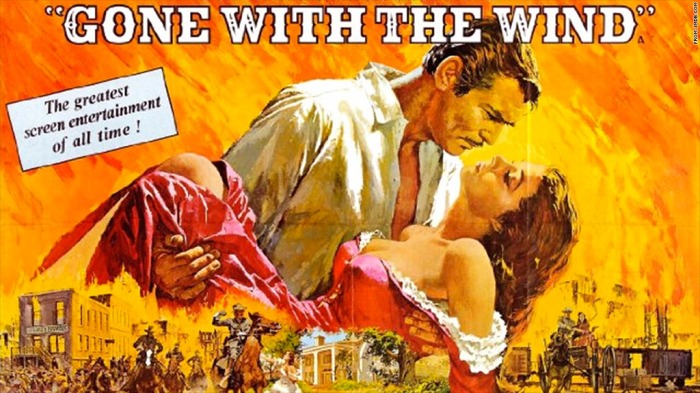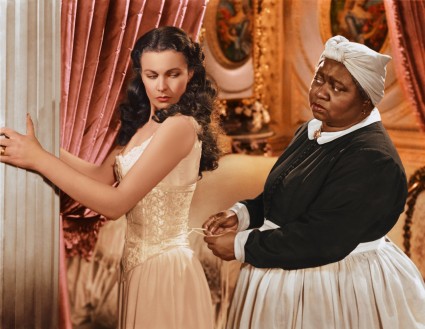- Production Company: Selznick International
- Year Released: 1939
- Directed By: Victor Fleming
- Starring: Vivien Leigh, Clark Gable, Leslie Howard, Olivia de Havilland
1939 is considered by most film critics, and any of the films nominated that year could have rightfully won that year. However, Gone with the Wind was one that was chosen, and on a superficial level, it’s easy to see why. It’s the first Best Picture winner to be entirely shot in color (which at the time used up nearly all of the color film available in the world). It had a cast of thousands, amazing costumes, new film techniques, a sweeping music score (once again provided by the talented Max Steiner) and it was based off of an extremely popular work of fiction (released in 1936) that has since gone down as one of the greatest ever and is a contender for The Great American Novel. If you factor in inflation, it is still the highest grossing film of all time. Everyone knows and loves this movie, so doing it justice is tricky by any sort of meaningful standard.

It is even difficult to know where to even begin with this film. As a southerner myself, this film means so much to so many different people. It’s a cultural touchstone that draws in everyone from all walks of life. I’ve met people in the south that I disagree with on just about every major political issue, but as soon as we get talking about Gone with the Wind, we become like the greatest pair of friends anyone is likely to find. So from a cultural and a historical point of view, the film is absolutely worth watching, but is it still worth watching solely as a piece of entertainment? the short answer is unreservedly yes.

For the five of you that are just now hearing about the book and this film. Gone with the Wind is about the eldest daughter of a wealthy plantation owner. Her name is Scarlett (Vivien Leigh), and she has just about everything that anyone could possibly want except for her crush Ashley (Leslie Howard), who is going to marry his cousin Melanie (Olivia de Havilland). During a party at Ashley’s house, she meets the lady’s man Rhett Butler (Clark Gable). The Civil War breaks out and the rest of the movie is about the life, death and rebirth of the Old South and what ordinary people will do to survive.
The overall plot is excellent. Like many other works of fiction, Gone with the Wind tries to paint a picture with its scenery rather than tell a linear plot of events. It’s just as much occupied with putting you in the mindset of the time as it is telling a story. From book to film, Selznick’s company pulled this off splendidly.

They also were able to translate the characters well to the screen. Of particular note is the stellar cast of main characters. This would be the third time that Clark Gable would appear in a Best Picture winner. However, Vivien Leigh’s portrayal of Scarlett is what makes the film. Scarlett O’Hara is one of the most compelling women in all of fiction. On the one hand, she may start out as a spoiled brat. But she goes through hell. She watched hundreds die, watched the damage and destruction of a city, delivered a baby, fought ruffians that wanted her dead, hid underneath a bridge, knowing full well she would die if she made a sound, lost a way of life and her mother and nearly starves to death. She vows that she’ll never be made to suffer again. The war forces her to awaken from the fairytale dream she was living in. But it came at a loss. She lost her childhood innocence and is a sense her own self with the loss of her old life. Only her memory of a childhood crush and of a home seemed to have kept her going. So she sold her soul and did despicable things just to get ahead in an effort to get even the slightest bit of the fairyland she existed in back. It is perhaps this clinging to the past that made her blind to all that she had in front of her. She’s a compelling case of a woman who sold her soul, yet still can be redeemed at heart. And Vivien Leigh captures her arc perfectly.
In fact, the entire cast goes through similar arcs, though many of them simply need to get their acts together. All of them are suffering from some form of loss or from delusions of grandeur or only help others if there is profit for them. The only exceptions are Melanie Hamilton, who couldn’t hate anyone if she tried, and the former slaves that stay behind. Despite reveling in the ways of the Old South, the characters in this movie seem to be hampered by being set in the old ways. It’s as if on the one hand, the film praises the Old South while at the same time attacking it for its simplistic worldview in a time when America was about to undergo an Industrial Revolution. So, without getting into too much of an analysis, the central themes seem to be loss of innocence and identity in an ever-changing world, the dangers of nostalgia, a warning against losing one’s way in pursuit of profit and most importantly learning to love what one already has.
As mentioned before, the main cast performs their job in exploring these themes well, though that is not to say that the supporting cast isn’t equally as good. Of particular note is Hattie McDaniel as Mammy. Mammy is a tough old slave woman who takes no grief from anyone. Though she also has a heart of platinum and would do anything for you. Her tear-filled explanation of Rhett’s behavior near the end of the movie earned Hattie McDaniel a Best Supporting Actress Oscar. She was the first African American to win an Oscar in the history of the Academy.

The film pioneered many different techniques, such as a super pan out so wide that they had to use a crane to get the footage. It also is subtle in the way It delivers gruesome content. During a scene involving a leg amputation without anesthetic, the viewer sees nothing but shadows. They only hear the screams and Scarlett’s disgusted face. Seldom do movies make me as uncomfortable as that scene. The movie also has a great use of color. Everything about it has an aura of mystique about it, mostly thanks to its use of dramatic use of colored lighting. The palette mostly consists of rich browns and vivid greens, sky blue and brilliant orange. The score is also incredible. Max Steiner gives his magnum opus with Gone with the Wind’s soundtrack. the main theme along is worth the price of admission. Another thing of note is that it was one of the first movies to use a cuss word. The producers and director fought tooth and nail with the censors of the time, and in the end, the line “Frankly my dear, I don’t give a damn” was included. It has since gone down as the greatest movie quote of all time according to the American Film Institute.
But that is just one classic Hollywood moment in a film of many. With its deep themes, solid acting, groundbreaking techniques, well-rounded characters and lengthy runtime, Gone with the Wind is a treat for the eyes and ears. I would say go out and see it, but chances are, you already have.
Next time, we tackle Rebecca. See you all then.
Order Gone With the Wind here.

